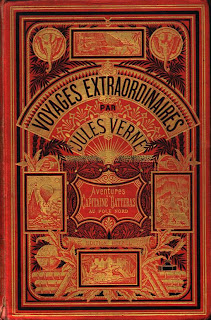
Born in 1919 in Montmartre (Paris), in the art studio of his grandparents, Hortense Dury-Vasselon et Marius Vasselon, both of whom were accomplished painters, Claude Le Baube lead a life of two passions: sailing and painting.
 Claude Le Baube in his studio in Aix-En-Provence. Jean-Marc Fray peruses his work...
Claude Le Baube in his studio in Aix-En-Provence. Jean-Marc Fray peruses his work...Le Baube started drawing very young. He was talented and encouraged by his parents, Marthe Vasselon and Robert Le Baube, excellent illustrators in their own right. As a child, he was a huge fan of Jules Verne and spent countless hours pouring over the lavishly illustrated Hetzel collection of Jules Verne novels which would serve as a source of inspiration throughout his life (for illustrating of course, but perhaps too, for his incredible gift of story telling - another art form he truly mastered during his lifetime).
 Front Cover of Hetzel Edition of The Adventures of Captain Hatteras by Jules Verne
Front Cover of Hetzel Edition of The Adventures of Captain Hatteras by Jules Verne
Le Baube's love for the sea and sailing led him to the
Ecole de Navigation, where he rapidly climbed to the position of Lieutenant. He served as a French Naval officer for the duration of WWII then joined the commercial Navy in 1945 as a Captain.
Throughout his 30-year career of voyages around the world aboard naval ships and cruise liners, Le Baube never neglected his love for painting. He always traveled with paint and brushes and set up his easel and canvases in ports of call around the globe. During his visits home, he frequented the Parisian art studios and studied under the masters Fernand Leger, André Lhote and Yves Brayer.
 "La Pasteque"
"La Pasteque"
still life and surreal scenes of mythical or imaginary inspiration. He also painted ships and historical naval battle scenes from all eras with extraordinary precision, exposing his talents as both a gifted artist and an erudite historian. He has illustrated more than 20 books for the French Navy. The last years of his life were spent with his family and two dogs in Aix-En-Provence where he painted profusely when he was not cooking, entertaining family, friends and a wide circle of admirers.
 Juliette Fray with "Gabelou".
Juliette Fray with "Gabelou". Jean-Marc in Claude Le Baube's Aix-En-Provence studio, 2005.
Jean-Marc in Claude Le Baube's Aix-En-Provence studio, 2005.
Awards:
La Jeune Peinture - Marseille 1960; 1st Prize
Concours du Palais Royal - Paris 1965; 1st Prize
 "Bataille de la Hague".
"Bataille de la Hague".
 "Plante".
"Plante".
 "Le Normandie".
"Le Normandie". "Nature morte".
"Nature morte". "Chapeau de paille".
"Chapeau de paille".
 "Bleu".
"Bleu".
































